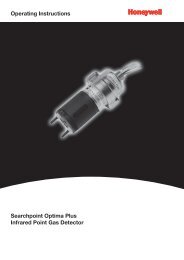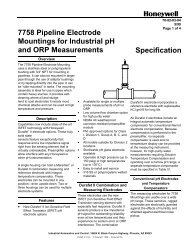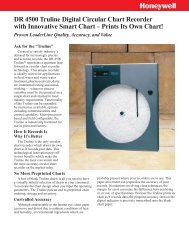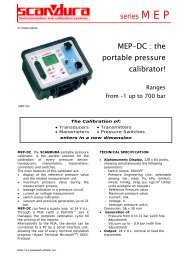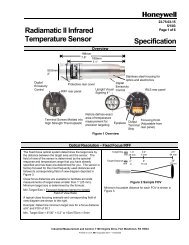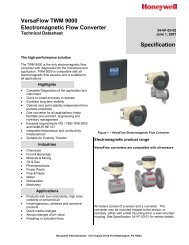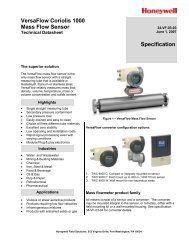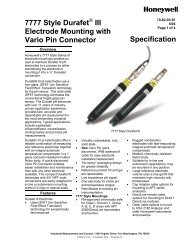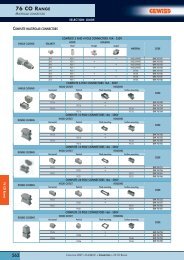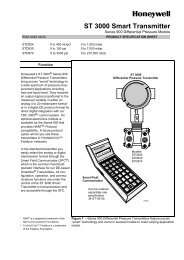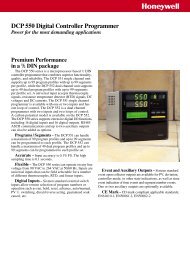PhD6 Multi-Gas Detector Reference Manual - Honeywell Analytics
PhD6 Multi-Gas Detector Reference Manual - Honeywell Analytics
PhD6 Multi-Gas Detector Reference Manual - Honeywell Analytics
Create successful ePaper yourself
Turn your PDF publications into a flip-book with our unique Google optimized e-Paper software.
1.10 PHD6 standard accessoriesStandard accessories included with every PHD6include calibration adapter, additional tubing foruse during calibration, manual sample draw kit,reference manual and quick reference card. Themanual sample draw kit consists of a sampledraw / calibration adapter, squeeze bulb,replacement sample probe filters, ten feet/threemeters of tubing and a sample probe.Standard configurations of the PHD6 aredelivered in a cardboard box with cardboardinserts.1.10.1 Alkaline PHD6 detectorsIf the PHD6 has been purchased as an alkalineinstrument, the standard accessories include analkaline battery pack and a set of 3 disposableAA alkaline batteries.1.10.2 Li-Ion PHD6 detectorsIf the PHD6 has been purchased as a Li-Ionrechargeable instrument, the standardaccessories include Li-Ion battery pack and aslip-in PHD6 charger.1.11 PHD6 kitsPHD6 detectors may also be purchased as partof a complete kit that includes calibration gas,fixed-flow regulator and a hard-shell carryingcase.1.11.1 PHD6 Confined Space KitsIn addition to the standard accessories listedabove, Confined Space Kits also includecalibration fittings, fixed-flow regulator withpressure gauge, and appropriate large cylinder(s)of calibration gas in a foam-lined, waterproofhard-shell carrying case.1.11.2 PHD6 Value PacksPHD6 Value Packs include an alkaline PHD6, allstandard accessories, calibration fittings, smallcylinder of calibration gas, and fixed flowregulator in a foam-lined non-waterproof hardshellcarrying case.2. Basic OperationsThe PHD6 is a three-button gas detector. Mostday-to-day functions are initiated solely with theMODE button. The MODE button controls: Turning the PHD6 on and off Turning on the backlight Viewing the MAX, STEL and TWA readingscreens Initiating the calibration sequence2.1 Turning the PHD6 OnTo turn the PHD6 on, press and hold the MODEbutton for one second. The introduction screen isfollowed by a screen showing a list of installedsensors and the sensor ports they occupy. ThePHD6 has 5 sensor ports, but can displayreadings for as many as 6 distinct gases.→The serial number will thenbe shown. If the detectorhas a fully enableddatalogger, the interval andmemory capacity will beshown.The sampling interval isgiven in minutes andseconds. The dataloggersamples continuously, so the data stream mustbe broken into intervals to be recorded. Thedatalogging interval defines the frequency of thebreaks in the data stream. The capacity is thenumber of hours and minutes it will take tocompletely fill the datalogger’s memory. Oncethe memory is filled, the PHD6 will start to writenew data over the oldest data in order toconserve that most recent data.The sampling interval in the fully enableddatalogger may be modified using BioTrak IISoftware, the IQ Systems or manually throughthe Main Menu.If the PHD6 is equipped withthe standard black boxdatalogger, it will show BlackBox.In the PHD6, a one-minutesampling interval will result inthe ability to store aminimum of 63 hours ofreadings before the oldest data is overwritten bynew data. If fewer than 5 sensors are used, thecapacity will increase.As the instrument performs abasic electronic self test, thedate, time, temperature andbattery type will bedisplayed. During the selftest,the PHD6 performs asystem memory check andtests to see if a motorizedpump is attached to theinstrument. If a pump is detected, it will be brieflyactivated during the self-test. For details on startup procedures for pump-equipped PHD6instruments see section 2.1.1 below.The PHD6 will then display each installed sensoralong with any associated alarms levels.10



